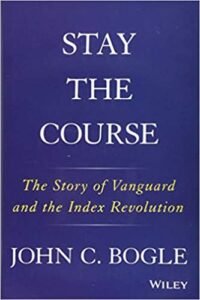25 Best Stock Market Books
The Best Books For Stock Market Beginners In India
Even if you’re a newbie or newcomer to the stock market, you’ll feel compelled to study everything there is to know about it from the ground up.Start with the most basic terms, such as A, B, and C, then work your way up to a more in-depth grasp of the material.On the internet, there are several platforms that have done an amazing job in this area.
However, when it comes to effectively learning anything, books have a distinct distinction and particular place.There are many different sorts of stock investment books written by a variety of authors. They must, however, be filtered based on customer comments and an index of the book’s contents.
Selectiion
For the year 2021, we’ve compiled a list of the top 25 Best Books For Stock Market Beginners in India. They’re all trying to sell you advice on how to invest and what to invest in. They will also aid you in understanding some basic stock market terminology.
You may find out more about the books’ contents by reading this article, and you can purchase them directly from Amazon. The necessary links have also been provided. These books should be purchased and read carefully, whether online or offline.
1. The Intelligent Investor- Mr. Benjamin Graham

This book was written by Mr. Benjamin Graham, the mentor of Mr. Warren Buffet, the greatest investor of all time. For good reason, it’s known as the “Bible of the Stock Market.“
The stock market’s basics are wonderfully described. This book is divided into three sections.
First, a defensive investor’s approach to investing. Market behavior and risk management are explained by the second and third ideas.
Despite the fact that Benjamin Graham’s book “The Intelligent Investor” was initially published in 1949, much of its original advice still remains true, from the significance of value investing and loss minimization to avoiding emotional decision-making in the financial markets.
The most recent version, however, has been updated with contemporary market data as well as comments and footnotes by financial journalist Jason Zweig. It has sold over a million copies globally and has received endorsements from industry leaders and newspapers such as Barron’s.
Mr. Benjamin Graham’s famous 1934 book illustrates how even novice investors may become savvy investors by simply evaluating firms and managing their long-term risks. The book’s main focus is on long-term profits rather than short-term advantages.
2. A Random Walk Down Wall Street- Burton G. Malkiel
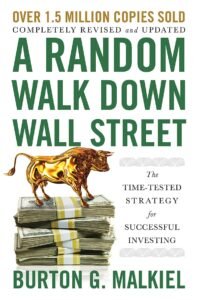
This book, now in its eleventh edition, is an excellent introductory read for anybody beginning a portfolio. Indexing, diversification, trends, bubbles, the significance of patience and time, and a slew of other key ideas are all prominent therein.
Burton G. Malkiel’s A Random Walk Down Wall Street, which has sold a million copies, remains near the top of investor reading lists for good reason.
This book, now in its 12th edition, offers a straightforward approach to investing, covering topics such as stocks and bonds, behavioral finance, and even physical assets like gold and coins. From Wall Street to the Great Wall and The Random Walk Guide to Investing was also written by Malkiel, the Chemical Bank Chairman’s Professor of Economics Emeritus at Princeton University.
3. The Little Book of Common Sense Investing- John C. Bogle

The Vanguard Group, founded by Jack Bogle, is recognized for offering the lowest-cost mutual funds in the market. Jack’s message is straightforward: keep costs low and invest for the long term in market indices. Common Sense on Mutual Funds, Jack’s second best-selling book, delves further into mutual fund investment. Jeremy Siegel’s Stocks for the Long Run is another excellent book with a similar premise.
If you don’t understand index funds, you don’t understand investing. John C. Bogle, the creator of the Vanguard Group, emphasizes this in his book “The Little Book of Common Sense Investing.” It delves into Bogle’s low-cost index fund investment technique, covering how to make index fund investing work for you and your portfolio.
This 10th-anniversary version has been revised to provide fresh material relevant to today’s market. Nonetheless, it remains a must-read for all investors. Bogle’s other books include “Common Sense on Mutual Funds” and “Enough.”
4. How To Make Money In Stocks- William O’Neil

This is a classic by William O’Neil that explains the ins and outs of his CANSLIM technique for discovering potential large winners in the stock market as well as how to time entry and exits. It is a fantastic guide for beginning investors since it mixes fundamental and technical research.
“How to Make Money in Stocks:
A Winning System in Good and Bad Times” is authored by William O’Neil, a well-known entrepreneur and the founder of William O’Neil & Co. Inc., a stock brokerage firm.
The book is an excellent addition to any investor’s library because it contains a wealth of information about stock market trading.
The author illustrates the finest methods and approaches by using examples from his personal trading experience.The “CANSLIM” approach, developed by the author himself, will be explained to readers.
The approach combines technical and fundamental research to assist an investor to learn how to limit losses on assets and when to do so. Aside from that, if you ever consider swing trading, you should keep track of certain swing trading books that will help you through the process.
5. The Most Important Thing Illuminated- Howard Marks

Howard put together a list of the 21 most important things to know about investing based on his Oaktree Capital client notes. The book covers “second-level thinking,” the price/value connection, patient opportunism, and defensive investment as well as other strategies for long-term success.
6. Reminiscences Of A Stock Operator- Edwin Lefèvre
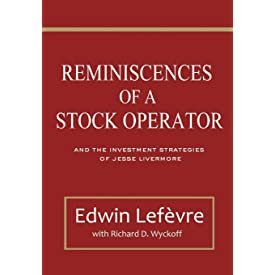
This is a page-turner of a novel. It’s a gripping account of how a young lad, despite falling penniless several times during his career, managed to accumulate one of the world’s greatest fortunes by speculating. He offers timeless investment advice (“I’ve always earned my money by sitting, not thinking”) that will benefit your trade for years to come.
7. Buffett: The Making Of An American Capitalist- Roger Lowenstein

This book provides insight into the Oracle of Omaha’s methods. Warren Buffett’s ideas are smart, and his strategies may pay off for those who have the patience to learn, understand, and implement them effectively.

Buy On Amazon
8. Market Wizards- Jack Schwager
This book contains interviews with successful traders from the 1970s and 1980s. Their tales are intriguing and motivating, and traders may learn a great deal from them. Jack Schwager’s original interviews became so well-known that he went on to write four more books: The New Market Wizards (1994), Stock Market Wizards (2003), Hedge Fund Market Wizards (2012), and The Little Book of Market Wizards, which summarised the most important lessons from nearly 50 interviews (2014)
9. Trade Your Way To Financial Freedom- Van Tharp
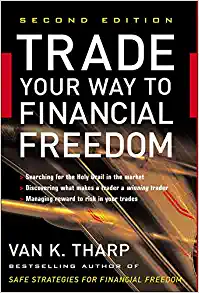
This is a rare find that covers both investor psychology and system design. While it may not provide you with the “Holy Grail” (an unbeatable strategy for trading the markets), it will provide you with the fundamentals you need to build a winning system. This book contains something for everyone.
Van Tharp, the author, is a well-known expert in the subject of trader psychology, having worked in the field since 1982. “Trade Your Way to Financial Freedom,” which was released in 2006, was a tremendous hit at the time and is still revered by investors. The book includes interviews with the author and some of his clients who he assisted in achieving better investing success.
The book includes chapters on investor psychology, fundamental analysis, technical analysis, and a systematic approach, among other advanced subjects. A beginner will learn some of the most important aspects of trading, such as money management and the risk-to-reward ratio, which may help investors avoid losses.
10. One Up On Wall Street- Peter Lynch
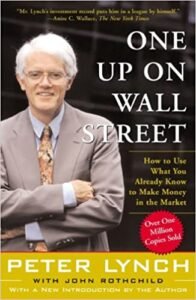
This is a timeless investment that will inspire individual investors. Peter Lynch explains why Wall Street may not be able to identify the finest investment possibilities right away and demonstrates how an individual investor may find the next big winner step by step.
Peter Lynch, the book’s author, is one of the most successful fund managers, with an average yearly return of 30% during a 13-year period. The book clearly covers the fundamentals and is a must-read for all beginners before embarking on their investing travels.
This book covers everything from planning to invest, how to invest when to invest, and why to a long-term investing strategy. Details on the various equities on the market, as well as how to acquire them, are also provided.
Do you want to be a step ahead of the competition?
So who better to learn from than one of history’s most illustrious investors? “One Up On Wall Street,” by Peter Lynch, focuses on how regular investors may beat professionals simply by seeing daily investing possibilities before they do.
Finding a “ten-bagger,” or a stock that increases tenfold after you acquire it is what this is termed. Lynch is the co-author of the blockbuster books “Beating the Street” and “Learn to Earn,” as well as vice-chairman of Fidelity Management & Research Company and former portfolio manager of Fidelity Magellan Fund.
The author of “One Up on Wall Street” is an excellent fund manager from the United States. The basics of the stock market, as well as techniques for profiting from it, are covered in this book. As a consequence, it is ideal for first-time investors.
If you want to make a long-term investment in the stock market, you must select the finest stock for you. Peter Lynch outlines the process for selecting the best stocks in his best-selling investing book. As a consequence, you’ll be able to obtain better returns on your investment items.
The investing book also includes six distinct types of companies, each of which necessitates a particular technique from those interested, as Peter describes below. Stock forms include slow growth/sluggards, stalwarts, fast growers, cyclicals, turnarounds, and asset plays.
11. The Little Book That Beats The Market- Joel Greenblatt
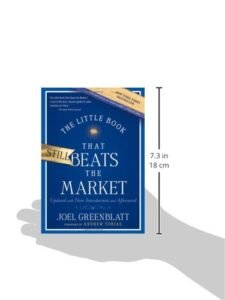
This book delves into the fundamentals of stock market investment. The author’s proven “magic formula investing” approach of beating the market by investing in high-quality firms at low costs is deconstructed in this book.
The revised version of Joel Greenblatt’s “The Little Book That Beats the Market,” which was initially released in 2005 and sold more than 300,000 copies, is fittingly titled “The Little Book That Still Beats the Market”.
It teaches prospective investors how to regularly outperform the market by following the author’s straightforward technique for buying stocks at rock-bottom prices. But don’t worry: Greenblatt explains everything in clear English and without jargon. This version includes information about the financial crisis, as well as how the formula fared throughout that period.
This book contains a lot of magical tips for outperforming the stock market and maximising profits. Earning Yield and Return on Capital are two of the most significant formulae given by the author. By selling equities at discounted prices, they earn the greatest money for investors. You will certainly obtain amazing outcomes if you use these strategies. As the title indicates, it is a collection of material crammed into a tiny number of pages (only 176 pages).
12. Liar’s Poker- Michael Lewis
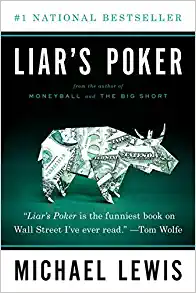
An insider’s perspective of Salomon Brothers in the late 1980s. A fascinating, if maybe unprofitable, account of how Wall Street operates. The Big Short: Inside the Doomsday Machine and Flash Boys are two more outstanding Michael Lewis books.
13. Alchemy Of Finance- George Soros

This book, as well as Soros’s more recent work The New Financial Paradigm, discusses the author’s reflexivity thesis and how it applies to the market. It is highly insightful and enhances one’s understanding of how the financial markets function, even if it does not give a direct trading mechanism. The book is thick, but those who are willing to finish it will be rewarded.
14. Fooled By Randomness- Nassim Taleb

This book, which complements “The Black Swan,” explores the author’s ideas on how randomness plays a greater influence in our lives than we realize. For traders, this means that risks are generally higher than we anticipate. It would also imply that not everything in the financial world is as it seems.
15. Japanese Candlestick Charting Techniques- Steven Nison
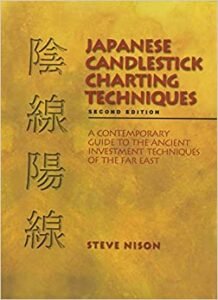
Candlestick charting is introduced in this book, which some investors may find beneficial in their trading. It certainly aids in making charts more visible!
16. Extraordinary Popular Delusions And The Madness Of Crowds- Charles Mackay

This book examines tulipmania, the South Sea bubble, and the Mississipi Land plan, demonstrating how herd mentality was used to generate bubbles in the past. It may be both an entertaining read and a useful guide for coping with future bubbles.
17. Common Stocks And Uncommon Profits- Philip Fisher

Buffett owes most of his success to Philip Fisher, who wrote this unappealing book. This book is a must-read for anyone who wishes to learn how to evaluate a firm qualitatively in the age of quantitative finance.
Common Stocks and Uncommon Profits is an in-depth look at financial ideas with enduring strength, updated from Philip A. Fisher’s classic tome on investing.
These topics vary from how to find growing firms to how to use the scuttlebutt approach, which entails obtaining information about a company from a variety of sources (ideally before you invest in the said company). The book’s second version, which contains advice from the author’s son Ken Fisher, a noted financial specialist, was first released in 1958 and was supported by Warren Buffett.
It’s a must-read for any investor since it sets out numerous fundamental concepts, such as keeping emotions out of the investment process.
18. Irrational Exuberance- Robert Shiller
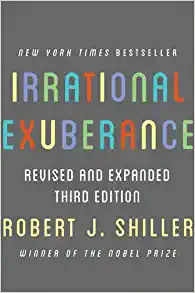
Robert Shiller, the 2013 Nobel Laureate in Economics, is a market expert who has devoted his career analysing market fluctuations. Irrational Exuberance, a multi-book author, looks at how trends evolve into booms and eventually burst bubbles.
19. When Genius Failed: The Rise And Fall Of Long-Term Capital Management- Roger Lowenstein
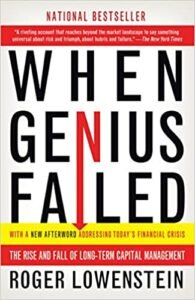
A fascinating account of how one of the hedge fund industry’s darlings grew to prominence and then plummeted. A reminder to traders to maintain risk and their circle of competence at the forefront of their minds.
20. Encyclopedia Of Chart Patterns- Thomas Bulkowski
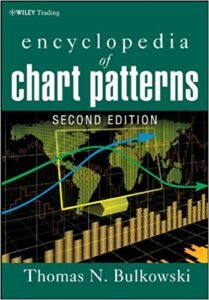
A fascinating account of how one of the hedge fund industry’s darlings grew to prominence and then plummeted. A reminder to traders to maintain risk and their circle of competence at the forefront of their minds.
21. Best For Millennials: The Financial Diet- Chelsea Fagan
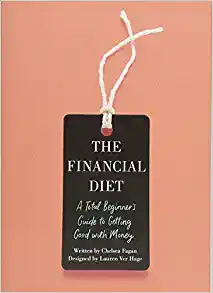
The Financial Diet, an Indie Personal Finance Bestseller, is a terrific place to start for millennials who need a crash lesson in money management. It covers topics such as how to make and stick to a budget, how to have difficult money talks with friends, and even what items to keep on hand in the kitchen (because eating out is a major budget killer). It also covers more complex financial subjects like how to care for your home and how to get started investing. The Financial Diet is a famous website and YouTube channel created by author Chelsea Fagan.
22. Best On The Psychology Of Investing: The Psychology Of Money- Howard Marks
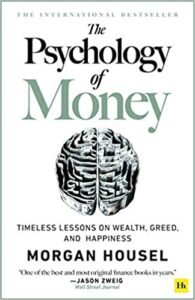
This collection of 19 short tales looks at how individuals think about money as well as the mathematics that go into financial plans and investments. This book’s message—emotions matter when it comes to money—rings true for everyone who has ever made an emotional decision about their budget or investment portfolio. Morgan Housel’s The Psychology of Money not only explains how our personal emotions, biases, and ego influence our financial decisions, but also provides readers with common sense tools to help them make those judgments. Housel, a former columnist for The Wall Street Journal and The Motley Fool, is a partner at the Collaborative Fund and an award-winning financial journalist.
23. The Little Book of Value Investing- Christopher H. Browne

Value investing is the strategy of buying cheap stocks and keeping them for extended periods of time in the hopes of generating higher returns when the equities recover. Despite the fact that it is not a new concept, many investors believe it is undervalued (pun intended). The Little Book of Value Investing by Christopher Browne explains how to use this technique to buy cheap stocks and increase your portfolio. The Independent, Financial Times (UK), Bloomberg, and The Wall Street Journal have all given this book high marks.
24. Best for Index Funds: Stay the Course- John C. Bogle
Index funds are critical in a passive investing approach, as every savvy investor knows. Stay the Course, by Vanguard founder John C. Bogle, is an interesting insight at investing vehicles, as he tells the storey of expanding his business from $1.4 billion to $5 trillion in assets, making it the world’s largest mutual fund firm. This book, which is part history and half index fund tutorial, is essential reading for every investor, expert or amateur.
25. Broke Millennial Takes on Investing- Erin Lowry
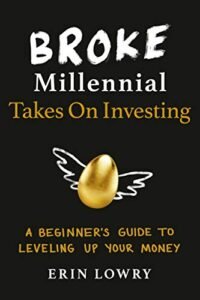
“Broke Millennial Takes On Investing,” by Erin Lowry, is one of the finest investing books for beginners because of its response to numerous topics aimed at millennial investors, such as “Should I invest while paying down student loans?” or “Should I use a robo-advisor or an investing app?” Lowry’s “Broke Millennial” series continues with the second part. Lowry has also been featured in USA Today, Cosmopolitan, and Refinery29, as well as in The New York Times, Wall Street Journal, and CBS Sunday Morning.
I hope you enjoyed and learned a lot from this essay. Thank you very lot for your help. If you have any questions about this post, please leave a comment. I, Aarti Devatwal, would want to express my sincere gratitude for taking the time to read this essay. I hope you learned a lot from this.
Which book is a writer by Warren Buffet’s Mentor?
Beniamin Graham, Warren Buffet’s mentor, wrote the book The Intelligent Investor.
What is the name of the author of One Up on Wall Street?
Peter Lynch, an American writer, is the author of One Up on Wall Street.
Which book is authored by John C. Bogle?
The Little Book of Common Sense Investing is authored by.
Tell us about Broke Millennial Takes on Investing?
“Broke Millennial Takes On Investing,” by Erin Lowry, is one of the finest investing books for beginners because of its response to numerous topics aimed at millennial investors, such as “Should I invest while paying down student loans?” or “Should I use a Robo-advisor or an investing app?” Lowry’s “Broke Millennial” series continues with the second part.


